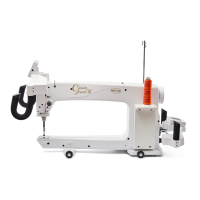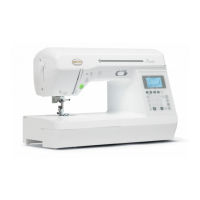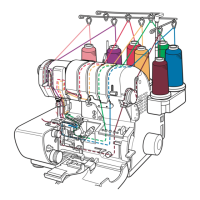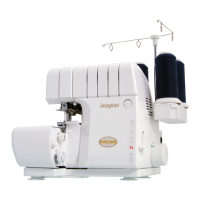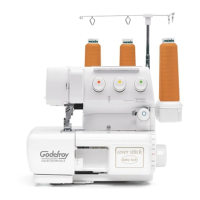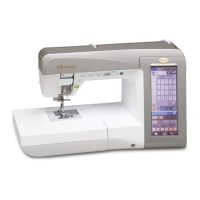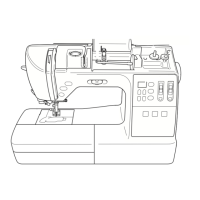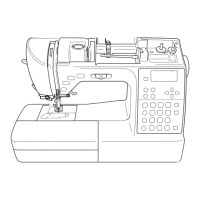Do you have a question about the Baby Lock Victory BLS3 and is the answer not in the manual?
Explains the fundamental working principle of a serger machine and its stitching process.
Details and illustrates the various parts and components of the Baby Lock Victory serger.
Lists and describes the accessories included with the Baby Lock Victory serger.
Provides information on recommended needle types, sizes, and replacement frequency for the serger.
Discusses suitable thread types, quality, and performance for optimal serging results.
Lists optional specialty feet available for purchase to enhance serging capabilities.
Guides users through the initial setup process, including placement, power connection, and cover opening.
Explains how to use the dial to lock or disengage the cutting blade for specific sewing situations.
Describes how to adjust the presser foot pressure for different fabric types and sewing needs.
Details the procedure for releasing and replacing the snap-on presser foot.
Explains the stitch length dial and its use for standard sewing and rolled hems.
Describes the stitch width adjusting dial and how it affects stitch formation and blade movement.
Explains how to use the differential feed to control fabric feeding and prevent puckering or gather.
Introduces the automatic thread tension adjustment system for consistent stitch quality.
Details how to use the stitch selector to choose different stitch settings for various applications.
Explains how to fine-tune looper thread delivery for perfect stitch formation.
Guides on how to engage and disengage the subsidiary looper for 2-thread serging.
Covers methods for preparing spools, cones, and thread nets for optimal feeding.
Introduces the 'Instant Jet-Air Threading System' for simplified looper threading.
Explains the necessary machine lock and handwheel positions for threading loopers.
Step-by-step instructions for threading the lower looper using the Jet-Air system.
Step-by-step instructions for threading the upper looper using the Jet-Air system.
Instructions for threading the right needle, including using the needle threader.
Instructions for threading the left needle, including using the needle threader.
Detailed guide on operating the automatic needle threader for efficient threading.
Explains how to start serging with fabric, including chain-off and fabric handling.
Describes how to clear threads from the stitch fingers after serging.
Provides instructions for re-threading loopers when a thread breaks.
Provides instructions for re-threading needles when a thread breaks.
Explains the basic use of overedging for finishing facings, hems, and seams.
Details how to stitch and finish seams in one operation for garments.
Details the 4-thread overlock stitch, its stitch formation, and recommended settings.
Explains the 3-thread overlock wide stitch for edge-finishing and seaming.
Describes the 3-thread overlock narrow stitch for specific seam applications.
Details the narrow hemming technique using a 3-thread overlock stitch.
Explains the rolled edge setting for narrow stitches on sheer and lightweight fabrics.
Details the 3-thread rolled edge stitch formation and application.
Guides on using the 3-thread rolled hem for sewing sheer fabrics.
Explains how to create a frilly or 'lettuce' edge on various fabrics.
Describes using the rolled edge thread chain for creating belt and button loops.
Describes the flatlock seam suited for fabrics that do not ravel, creating a non-bulky joining.
Provides an economical and less bulky means of overedging fabrics.
Guides on converting the machine from 3-thread to 2-thread serging.
Explains the 2-thread flatlock seam, often considered a decorative application.
Describes the narrow 2-thread flatlock seam, suitable for decorative applications.
Details how to use the flatlock stitch for decorative effects on fabric folds.
Explains how to create a sturdy, nearly invisible blindhem using the 2-thread overlock.
Guides on creating a decorative blanket stitch using a specific threading path.
Details how to create a decorative ladder stitch with a unique threading path.
Provides instructions to revert the machine settings to standard 3 or 4-thread overlock.
Explains methods for securing serged seams to prevent unraveling.
Details on how to lock the beginning and end of a seam by serging over previous stitches.
Guides on how to serge around outside corners of fabric.
Details how to serge around inside corners of fabric.
Explains how to guide fabric around curves while serging.
Describes using the presser foot slot to insert stabilizing tape, elastic, or ribbon.
Explains how to use the front cover markings for seam allowances.
Discusses using specialty threads, cords, and ribbons for decorative effects and enhanced stitches.
Explains threading lightweight specialty threads in the needle and loopers.
Guides on how to change threads, including tying knots and pulling threads through.
Describes threading medium weight threads that may require a 'cradle' for loopers.
Provides detailed steps for creating and using a thread cradle to thread loopers with specialty thread.
A chart detailing thread compatibility for various stitch types and applications.
Details the procedure for safely removing and inserting new needles.
Guides on how to replace the upper moving cutting blade.
Provides instructions for cleaning the serger, including removing the needle plate.
Information on the LED lighting system and when to contact a retailer for replacement.
Lists common machine problems and checks to perform before seeking service.
Lists important guidelines and actions to avoid for safe and proper machine operation.
Troubleshooting steps for issues related to needle and looper threading.
Troubleshooting steps for problems with cutting action and fabric feeding.
Provides specifications for stitch types, width, length, differential feed, and machine weight.
A summary chart of suggested settings for various stitch types and applications.
| Brand | Baby Lock |
|---|---|
| Model | Victory BLS3 |
| Category | Sewing Machine |
| Language | English |

